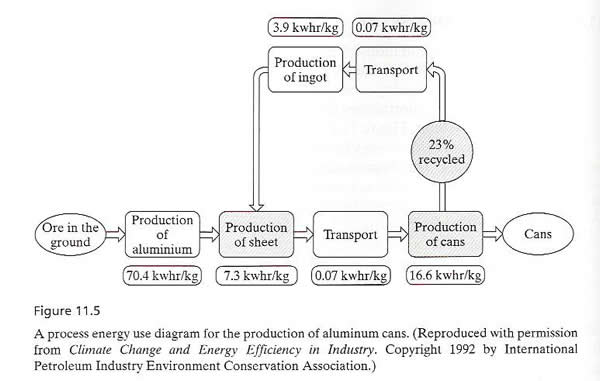Lecture 14: Catch-up and climate change discussion
Thur, Feb 25, 2010
| |
1. return quiz |
|
| |
2. assignment 2 - questions? |
| |
3. solar energy policy |
| |
4. Life Cycle Analysis |
| |
5. Climate change discussion |
|
1. Return quiz
comment on grading
answer specific questions
|
2. Assignment 2 - questions
What are the differences between efficiency and reduction?
|
3. Some energy policy
Oregonian article about trying to use incentives to promote solar PV generation
Mr Solar - calculations
simple accounting for solar panels
- calculate the number of KWatt*hrs produced over a year
- panel rating * number of hours of sun equivalent to the full rating (might be 4 per day)
- panel rating might be 10 panels at 80 watts/panel = 800 watts
- means you'd get 3.2 kwatt*hr per day or 1168 kwatt*hr per year
- at $0.12 per kwatt*hr thats only replacing $140 worth of electricity
- at about $5 per watt of solar panel = $4000 - it'd take a long time to pay back
- not counting all the other stuff needed (grid-tie, inverter, mounting brackets, etc)
Oregon incentives, tax breaks, and refund of some sort on the panels
Oregon Energy Trust
go to the calculator and the example payments
feed-in tarrif - the price electric companies have to pay you for the power you put into the grid
- suggested at $0.25 to 0.85 per kwatt*hr
- $20,000 for 3 kwatt system (which only produces 3*4hr/day*30day/mo) = 360 kw*hr/mo)
- which would pay back (360 * .25*12) or (360 *.85*12) = $1080 or $3672 per year making
- payback time is equal to about 20 years down to 5 1/2 years.
|
4. Energy accounting
The questions are:
1) Is it better to build expensive stuff that requires less energy to run or use cheaper stuff?
- higher embedded and lower operation energy
- lower embedded and higher operation energy
2) How do we account for these different types of energy and make decisions based on that information?
4 examples:
- home energy
- aluminum recycling
- foot-print of a car
- life-cycle analysis of cars
|
a. Home energy
How much energy is saved when we build an energy efficient house?
How much energy is in all the materials in a house?
link
energy efficient vs. standard home
cold climate
What can we do in warm climates? Roofing designed to radiate heat.
|
b. aluminum recycling

Energy savings of:
for each can recycled
0.07 + 3.9 +7.3 + 0.07 + 16.6 = 27.94
70.4 + 7.3 + 0.07 + 16.6 = 94.37 kwhr/kg of aluminum
28/94 = only 30% as much energy per can
some estimates say that it's only 5% of the energy for a recycled can
even assuming 5 kwhr/kg of cans:
75 cans per kg
67 watt*hr per can
unrecycled can would be 1300 watt*hr/can
20 of those cans would be equivalent to a gallon of gas in energy
Discuss -
|
c. carbon footprint of a car
Carbon footprint is the amount of average arable land it would take to consume the carbon emitted by the particular activity.
example - ecological footprint of using a car
|
d. life cycle analysis
full accounting of costs from construction, through use, and to recycling or disposal
simple example:
- energy used to construct an automobile (about 10 to 15%)
- energy used during the life of the vehicle
(about 75 to 85%)
- energy used to deconstruct and dispose of the vehicle (about 5 to 10 %)
controversy "Prius vs. Hummer - dust to dust"
claims by the CNW Marketing:
- Prius is more expensive to operate ($2.87/mile) (mostly from gas costs) over its lifetime than a Hummer ($2.07).
- Nickle used in the Prius is causing destruction of the forests in Canada.
- Recycling and disposal costs for the battery in the Prius would be very high.
these ideas were picked up by the media and may have "disorted the public debate" (according to the Pacific Institute).
response for other institutions that study such issues
- the claims are very sensitive to the assumptions
- CNW didn't publish assumptions or have any peer review that might have helped catch these
- for example used 109k miles for Prius and 379k miles for the Hummer H1, and 12 year lifetime for the Prius and 35 years for the Hummer.
- CNW assumed that the majority of the energy is associated with the production of the vehicle whereas all other studies show it's around 10%
links:
|
5. Discussion - Climate change
|
|


![]()